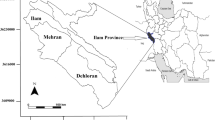Abstract
Tularemia is a zoonotic disease caused by the coccobacillus F. tularensis. Small epidemics and sporadic cases were seen around Bursa since November 1988. In this study, a total of 205 cases of tularemia were observed. All the cases were diagnosed on clinical, bacteriological and serological grounds. The epidemics were thought to be waterborne. The majority of the patients were young and female. In most of the cases the disease presented itself in oropharyngeal form (83%). Analysing sera from the patients with microagglutination method demonstrated that titers were ≥ 1:160 in approximately 85% of the cases, including the ones in subclinical form. Five of ten patients from who the bacteria was isolated were seronegative. Streptomycin was given to the most of the patients by combining with tetracycline, doxycycline or chloramphenicol. The early administration of these antibiotics (before the third week of disease) was found to be much more effective to resolve the infection. As a result, the main mode of transmission of F. tularensis is waterborne in our region. In our region, tularemia should be considered in differential diagnosis for the cases with fever, tonsillopharyngitis and cervical lymphadenopathy to make an early diagnosis and to design relevant treatment.
Similar content being viewed by others
References
Sandström G, Sjöstedt A, Forsman M, Pavlovich NV, Mishankin BN. Characterisation of strains of Francisella tularensis isolated in the central Asian focus of the Soviet Union and in Japan. J Clin Microbiol 1992; 30: 172–175.
Syrjälä H, Kujala P, Myllyla V, Salminen A. Airborne transmission of tularemia in farmers. Scand J Infect Dis 1985; 17: 371–375.
Taylor JP, Istre GR, McChesney TC, Satalowich FT, Parker RL, McFarland LM. Epidemiological characteristics of human tularemia in the southwest-central states. 1981–1987. Am J Epidemiol 1991; 133: 1032–1038.
Penn RL, Kinasewitz GT. Factors associated with a poor outcome in tularemia. Arch Intern Med 1986; 147: 265–268.
Klotz SA, Penn RL, Provenza JM. The unusual presentation of tularemia. Arch Intern Med 1987; 147: 214.
Christenson B. An outbreak of tularemia in the northern part of central Sweden. Scand J Infect Dis 1984; 16: 285–290.
Gotschlich E, Berkin T. 1936 yılında Trakya'da tularemiye ait yapılan epidemiyolojik ve bakteriyolojik çalışmalar. Tr Hij Tec Biol Derg 1938; 1: 115–122.
Dirik K. Van Gölü havzasinda tularemi. Tr Hij Tec Biol Derg 1939; 2: 193–194.
Utku IE. Antalya'da tularemi epidemisive hususiyetleri. Tr Hij Tec Biol Derg 1954; 2: 288–291.
Gedikoğlu S. Francisella tularensis isolation from various clinical specimens. Clin Microbiol Infect 1996; 2: 233–235.
Claridge JE. Miscellaneous gram-negative coccobacilli Pasteurella, Francisella, Bordetella, and Brucella. In: Howard BJ, Klass JII, Weisfeld AS, Rubin SJ, Tilton RC (eds), Clinical and pathogenic microbiology. St Louis: CV Mosby Company, 1987: 439.
Brown SL, McKinney FT, Klein GC, Jones WL. Evaluation of a safranine-o-stained antigen microag glutination test for Francisella tularensis antibodies. J Clin Microbiol 1980; 11: 146–148.
Enderlin J, Morales L, Jacobs RF, Cross JT. Streptomycin and alternative agents for the treatment of tularemia: Review of the literature. Clin Infect Dis 1994; 19: 42–47.
Jacobs RF. Tularemia. In: Fauci AS, Braunwald E, Isselbacher KJ, Wilson JD, Martin JB, Kasper DL, Hauser SL, Longo DL (eds), Harrison's principles of internal medicine, vol. 1. New York: Mc Graw-Hill, 1998: 971–975.
La Regina M, Lonigro J, Wallace M. Francisella tularensis in captive wild caught prairie dogs. Lab Anim Sci 1986; 36: 178–180.
Eigelsbach HT, McGann VG. Genus Francisella. In: Krieg NR, Holt JG (eds), Bergey's manual of system-atic bacteriology, vol. 1. Baltimore: Williams & Wilkins, 1984: 394–399.
Mörner T. The ecology of tularaemia. Rev Sci Tech Off Int Epiz 1992; 11: 1123–1130.
Rowland MD, Griffiths DW. The spider as a possible source of tularemia. JAMA 1988; 260: 33.
Evans ME, Gregory DW, Schaffner W, McGee ZA. Tularemia: a 30-year experience with 88 cases. Medicine 1985; 64: 251–269.
Akdiş AC, Kiliçturgay K, Helvacı S, Mıstık R, Oral B. Immunological evaluation of erythema nodosum in tularaemia. Br J Dermatol 1993; 129: 275–279.
Bondi EE, Lazarus GS. Panniculitis. In: Fitzpatrick TB, Eisen AZ, Wolff K, Freedberg IM, Austen KF (eds), Dermatology in General Medicine, Third Edition. New York: McGraw-Hill, 1987: 1131–1148.
Sjöstedt A, Ericksson U, Berglund L, Tarnvik A. Detection of Francisella tularensis in ulcers of patients with tularemia by PCR. J Clin Microbiol 1997; 35: 1045–1048.
Bevanger L, Maeland JA, Naess AI. Agglutinins and antibodies to Francisella tularensis outer membrane antigens in the early diagnosis of disease during an outbreak of tularemia. J Clin Microbiol 1988; 26: 433–437.
Uhari M, Syrjala H, Salminen A. Tularemia in children caused by Francisella tularensis biovar palaearctica. Pediatr Infect Dis J 1990; 9: 80–83.
SyrjäläH, Koskela P, Pipatti T, Salminen A, Herva E. Agglutination and ELISA methods in the diagnosis of tularemia in different clinical forms and severities of the disease. J Infect Dis 1986; 153: 142–145.
Sato T, Fujita H, Ohara Y, Homma M. Microagglutination test for early and specific serodiagnosis of tularemia. J Clin Microbiol 1990; 28: 2372–2374.
Junhui Z, Ruifu Y, Jianchun L, Songle Z, Meiling C, Fengxiang C, Hong C. Detection of Francisella tularensis by the polymerase chain reaction. J Med Microbiol 1996; 45: 477–482.
Schell O, Reiersen R, Hoel T. Treatment of tularemia with ciprofloxacin. Eur J Clin Microbiol Infect Dis 1992; 11: 447–448.
Author information
Authors and Affiliations
Rights and permissions
About this article
Cite this article
Helvacı, S., Gedikoğlu, S., Akalın, H. et al. Tularemia in Bursa, Turkey: 205 cases in ten years. Eur J Epidemiol 16, 271–276 (2000). https://doi.org/10.1023/A:1007610724801
Issue Date:
DOI: https://doi.org/10.1023/A:1007610724801




